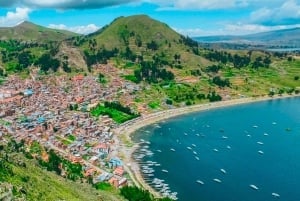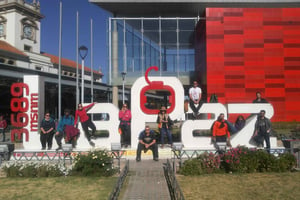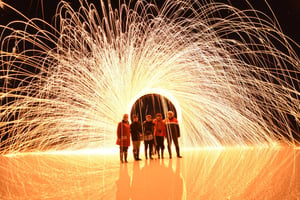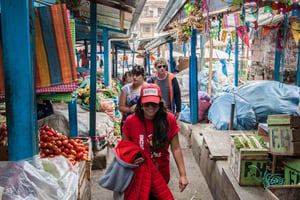Bolivia Lesser-Known Tourist Attractions
Book Top Experiences and Tours in Bolivia:
If youʻre booking your trip to Bolivia last minute, we have you covered. Below are some of the top tours and experiences!- La Paz: Uyuni Salt Flats & San Pedro de Atacama 3-Day Tour
- From La Paz: Titicaca, Copacabana, and Isla del Sol Day-Trip
- Medellín: Ride an E-Bike Like a Local with Snack Included
- La Paz: Full Day Trip to Copacabana and Isla del Sol
- La Paz: Death Road Guided Mountain Biking Tour with Lunch
Here are some of Bolivia's best-kept secrets that are worth checking out:
Huayna Potosí:

A majestic mountain located in the Andes of Bolivia, towering at an altitude of 6,088 meters (19,974 feet) above sea level. It is one of the most popular climbing destinations in South America due to its accessibility and challenging ascent. Huayna Potosi offers climbers a thrilling adventure with spectacular views of the surrounding mountain ranges and glaciers. The climb requires technical skills and acclimatization due to its high altitude and harsh weather conditions. However, it is an achievable goal for experienced climbers with the right training and equipment.
Parque Cretacico

Also known as Dinosaur Park, is a one-of-a-kind attraction that offers an immersive and educational experience for visitors of all ages. The park is situated on a hillside overlooking the city of Sucre and features over 50 dinosaur replicas from the Cretaceous period. The replicas are carefully crafted to look as lifelike as possible, providing visitors with an immersive experience of what the dinosaurs might have looked like in their natural habitat.
One of the main attractions in the park is the T-Rex replica, which stands over 36 feet (11 meters) tall and is one of the largest dinosaur models in the world. Visitors can also explore the park's interactive exhibits, including a fossil museum and a paleontological research center. In addition to its educational value, Parque Cretacico is also a popular destination for families and children. The park offers guided tours, workshops, and interactive activities, such as digging for dinosaur bones and making plaster casts of fossils.
The Vergel Canyon

Located in Toro Toro National Park, in the Department of Potosí, The Vergel Canyon is one of the country's most beautiful canyons, characterized by its towering rock formations, crystal-clear streams, and lush vegetation. The canyon is a popular destination for nature lovers and adventure seekers alike. Visitors can hike through the canyon, take a refreshing swim in its natural pools, and explore the hidden caves and waterfalls that are scattered throughout the area. The canyon is also home to a variety of wildlife, including monkeys, birds, and reptiles.
The place offers the opportunity to experience the local culture as is home to several indigenous communities who have lived in the region for centuries. Visitors can learn about their traditional way of life, try local cuisine, and witness their unique customs and rituals. And for those looking for an adrenaline rush, the canyon also offers several adventure activities, such as zip-lining, rappelling, and rock climbing.

Also located in Toro Toro National Park, Uma Jalanta offers visitors a unique opportunity to explore a vast underground cavern, with a river that runs through the heart of it, disappearing in the darkness.
As you make your way through the cave, you'll be surrounded by towering stalactites and stalagmites, formed over thousands of years by the slow drip of mineral-rich water. The natural beauty of the cave is truly awe-inspiring.
But the adventure doesn't stop there. Uma Jalanta is also home to a variety of fascinating wildlife, including blind fish that have adapted to the pitch-dark conditions of the cave. Seeing these creatures up close is a once-in-a-lifetime experience that you won't soon forget.
Sajama National Park

Named after the Sajama Volcano and covering an area of 1,020 square miles (2,650 square kilometers), Sajama National Park is a protected area located in western Bolivia, near the border with Chile. The landscape of Sajama National Park is dominated by the towering peaks of the Andes mountain range, vast grasslands, and high-altitude wetlands known as bofedales. The park's most prominent feature, the Sajama volcano, is an active stratovolcano that last erupted over 1,000 years ago. It is a popular destination for hikers and mountaineers, who come to test their skills and enjoy the stunning scenery.
But maybe one of the main attractions of the park is the hot springs of Aguas Termales de Polques. The hot springs are located near the base of the Sajama volcano and offer a relaxing soak in natural pools with stunning views of the surrounding mountains.

La Senda Verde is a non-profit organization and wildlife sanctuary located in the Yungas region of Bolivia, near the town of Coroico. Its mission is to rescue and rehabilitate animals that have been victims of the illegal wildlife trade, habitat destruction, or abuse. The sanctuary is home to over 700 animals, including monkeys, parrots, macaws, bears, cats, reptiles, and many other species. Most of these animals were rescued from the black market, where they were often kept in poor conditions or used for entertainment purposes. At La Senda Verde, they receive medical care, proper nutrition, and a safe and natural environment where they can live and thrive.
Visitors to the sanctuary can take a guided tour and learn about the animals and their stories. They can also volunteer to help with various tasks, such as feeding and caring for the animals, maintaining the facilities, and assisting with educational programs.

Tiwanaku is an ancient archaeological site located near Lake Titicaca in western Bolivia. The site was once the center of a powerful pre-Columbian civilization that flourished from around 400 AD to 1100 AD. Today, Tiwanaku is considered one of the most important archaeological sites in South America.
The Tiwanaku site includes several impressive structures and artifacts, including The Akapana Pyramid (a massive stone structure that was once over 50 feet tall), The Kalasasaya Temple ( a ceremonial platform that is believed to have been used for religious ceremonies and astronomical observations) and The Sun Gate (a large stone structure that features intricate carvings of deities and symbols). One of the most interesting aspects of Tiwanaku is its unique architectural style. The buildings at Tiwanaku are made from large, precisely cut stones that fit together without the use of mortar. Another fascinating aspect of Tiwanaku is its cultural and religious significance. The Tiwanaku civilization was known for its advanced astronomical knowledge and its worship of powerful deities. Many of the structures at Tiwanaku are aligned with celestial events, such as the solstices and equinoxes.
These are just a few of Bolivia's hidden gems that are waiting to be discovered. Whether you are interested in history, nature, or culture, Bolivia has something to offer for everyone. So why not venture off the beaten path and discover some of the country's less-known attractions?








































